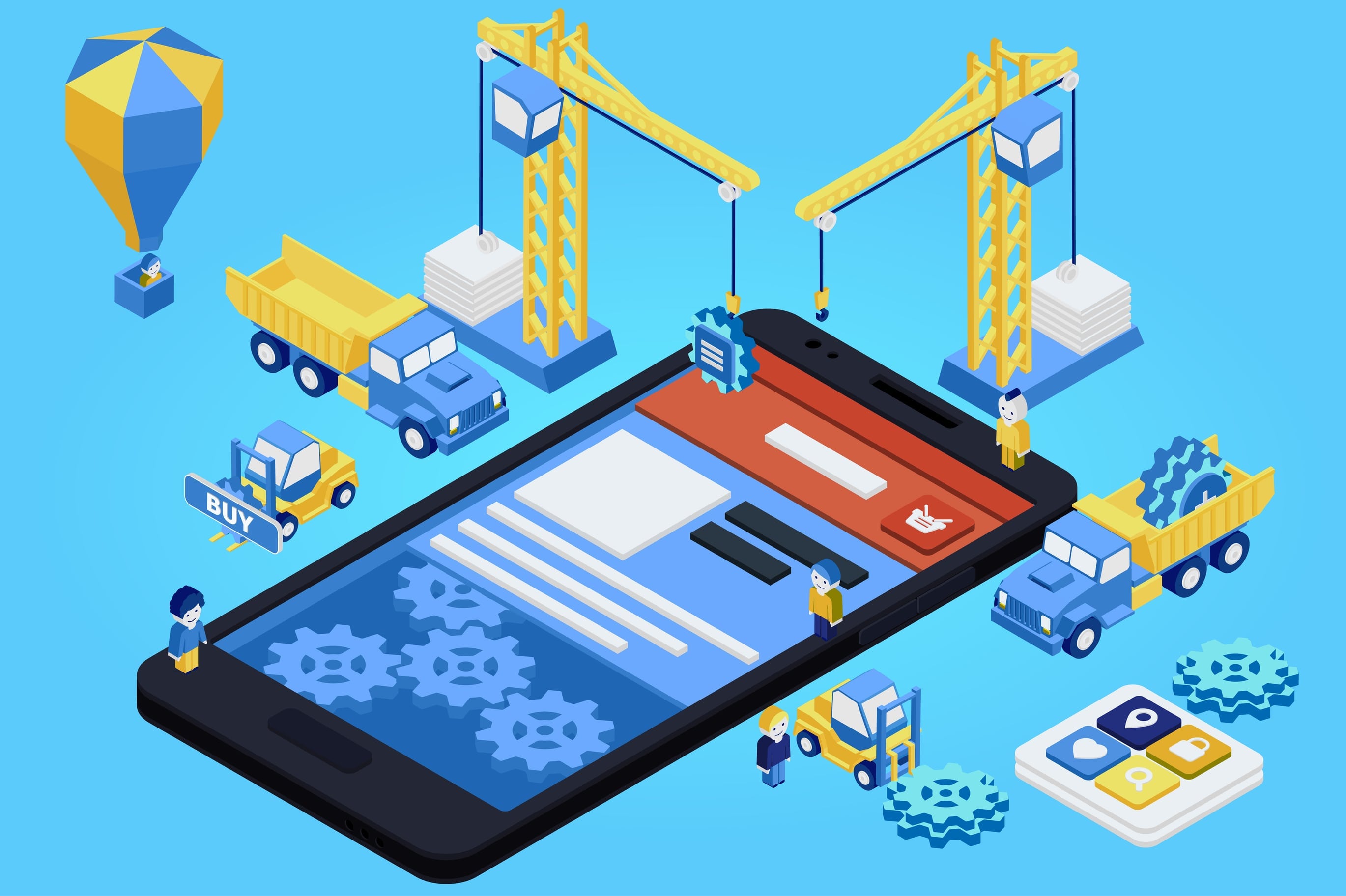
As of Q1 2018, there were 3.8 million apps available in the Google Play Store and 2 million available in the Apple App Store. That is a lot of competition. We want to help your mobile application stand out from the crowd.
The first thing you have to do? Step back from programming, and figure out what your end product should be.
A successful mobile app requires a broader focus on the entire product. You need to understand who will use it, how it will be used, and what its purpose is. You can’t make a good, successful product without understanding what will make it valuable.
There is a three-phase process you can follow to make sure you stay focused on the product and not just the code. Let’s review each phase—and provide some mobile app development tips while we’re at it.
Phase 1: Is there a market for your mobile app?
Before you do anything, make sure there is, in fact, a market for your mobile app. That market will either be external customers willing to buy or use your app, or internal users within your organization if it’s an enterprise app.
Questions to keep in mind when determining the market for your mobile app are:
- What is the mobile application supposed to do? Be specific when answering this question. Does it make performing a task more efficient? Does it bring your customers closer to your business? What is its purpose? What makes it valuable—both for you to produce, and for the customer to use?
- Are there similar mobile apps on the market that already fill this need? If so, how will yours be different? Do you see ways they can be improved? (Improvements on competing apps’ offerings should be focused on the user experience, as this is what will draw people away from existing applications and towards yours.)
The amount of time you need to spend on market research can vary widely. If you’re building a mobile application for use within your organization, for example, less time can be spent on this step as your market is small and contained.
On the other hand, mobile applications that will be competing in the app stores for downloads and new users require more time and attention in this stage. Spending time researching the apps already on the market will help you determine how your app will be different. What unique features or benefits will your app provide?
It may be tempting to rush this step, but that often leads to failure later on if you neglect to analyze the competition appropriately. You must identify a niche or unique selling point that will make your mobile application stand out.
Believe me when I tell you: trying to guess what customers want (and value) will not help. You need to do the research, so you can guide your development correctly.
Phase 2: Define the user journey
Success will come from your users loving your mobile application and regularly using it. This makes the user journey extremely important.
The user journey, or customer journey, focuses on how a user will interact with your app during a session. It requires taking a close look at how you envision the UX (User Experience) for your mobile app.
The app is an extension of your business or service; their journey might begin in the app, but it doesn’t end there. Customers’ experiences with your entire business is part of their journey.
Defining the user journey makes your mobile application a better product— and it keeps the focus on the customer and end product. That’s the main ingredient for a successful, revenue-generating app.
Clearly define what journey you want users to take with your mobile application. You may need to segment users into different categories in order to do this properly.
Is your mobile application more attractive to an older audience or a younger generation? Is it more pertinent to men or women? Who are you trying to serve?
Most established businesses have a good understanding of this already, but as you move into the mobile application space, sometimes the answer changes. Your mobile app may be more appealing to a specific segment of your typical target audience. These are things you need to consider when creating a user journey.
- Identify user behaviors—What actions (both general and specific) will they take when interacting with your app?
- Identify user objectives—What do your users want to get from your mobile app? What purpose does it serve? What will make them want to keep using it?
- Identify interaction points—How will you interact and engage with users within the app? Will you use in-app messages or notifications?
- Identify questions and barriers—Are there any uncertainties or bottlenecks that prevent the user from smoothly moving from one section of the application to the next?
The data you need to create a customer journey can be gathered from surveys, interviews, and a variety of other testing methods to make sure the information you gain is appropriate and relevant. Be sure to acquire data from a representative group that mirrors the target users of your mobile app.
When mapping out your user journey, keep it simple. Users do not want to spend more time in your application than necessary. Your user journey should map out an efficient and clean process to get your users to the desired end goal.
To read more on usability and how to achieve it without going over budget, check out our recent blog post.
Phase 3: The mobile application development process
You know there is a market for your mobile app, and you have spent time mapping out a user journey. It is now time to dig into the mobile application development process. There are three stages in this process.
1. Mockups / real user testing
Naturally, you want to put something in your users’ hands to see what they’ll really think about your mobile app. But you shouldn’t build the actual app just yet, as your users may not respond to it the way you expect. Again: you can’t just guess what they’ll value. Instead, use mockups.
A prototype or mockup allows users to see what the app will look like, and get a good sense of the app UX. You can watch this interaction and analyze it. You can also ask users questions on their experience with the prototype to identify potential pain points that need to be addressed.
A representative sample of people should once again be used during prototyping. That will make sure the feedback you receive will be applicable to your target audience.
Prototyping is a cost-effective way to test how your app will work in the real world without investing a lot of time or money into the application development process. There are several tools on the market to help you build a quick mockup:
- InVision is a web-based tool that allows you to create interactive mockups.
- Marvel is another prototyping tool that greatly simplifies the mockup process.
2. Build a new kind of MVP
Many businesses are focused on creating a Minimum Viable Product (MVP) in accordance with Agile methodologies. This is the most basic form of your mobile application that functions and allows users to start interacting with it in the marketplace.
Though we like Agile, we advise against this.
Releasing an application that is “minimally viable” is not going to create a solid reputation for your business or your application in the market—especially if you are an established business with customers expecting a certain level of quality.
You should instead create a Minimum Valuable Product (MVP).
A Minimum Valuable Product:
- Functions properly
- Has great usability
- Is used repeatedly by users and recommended to others
- Generates revenue
Your customers are happy because they get full value out of the investment they made in purchasing or downloading your app. And you’re happy because it generates positive revenue.
Creating a Minimum Valuable Product is an iterative process that evolves over time as you update and improve your mobile application. It should be the goal for any successful mobile app.
Your initial release of your MVP is the simplest version of the mobile app that still delivers on the value your customers will expect from the application. At this stage, it will be accepted, and customers will be happy. That said, you also have avoided overinvesting, because you didn’t spend time and money adding more features and functions than were required to address the main value of the app.
3. Analyze and refine
Once you build it, you need to understand how users interact with and use your application in production. There are several mobile app analytics tools you can use to capture pertinent data and analyze it so you can improve the user experience.
Types of data you want to capture are:
- Number of users
- Length of sessions
- How users navigate through the app
- Which features are used most often (and which are not used much, if at all)
- The last feature or function used before a user exits the app
- Crash reports
Inapptics is an example of such a tool, and Adobe has an offering as well. This data should be used to update and improve your mobile application through the product life cycle.
The phases outlined above are designed to keep you focused on the end product and the users you’ve targeted. Focus on that, and avoid simply writing code to build a mobile app that “just works.” Instead, a properly researched and planned app will be well-received in the marketplace and generate top-line revenue.
If you don’t have the knowledge on your team to follow the correct process, seek expert advice in custom mobile application development. This expertise will make the difference between releasing what amounts to just another mobile application on the market, and making money on a mobile application.


